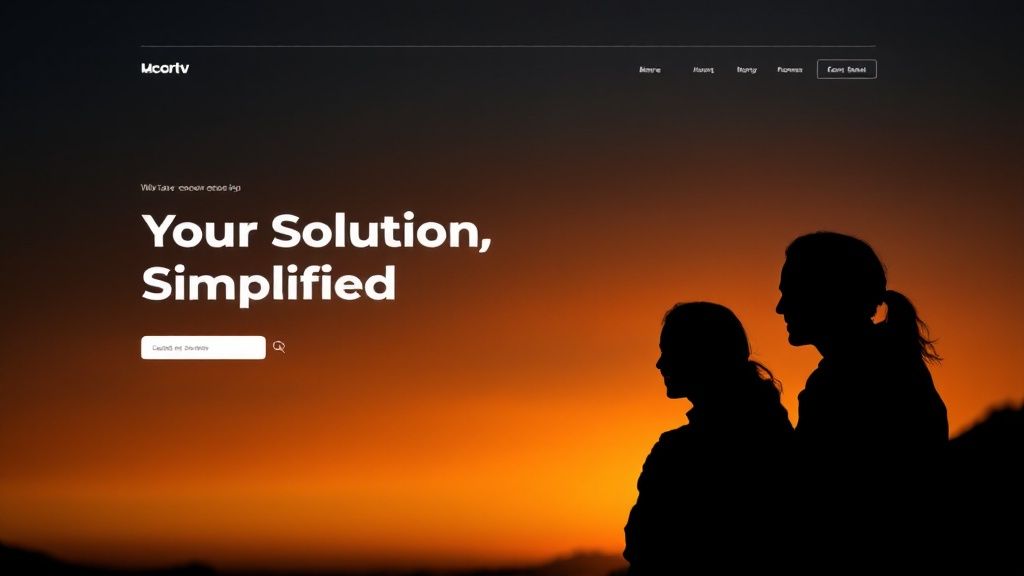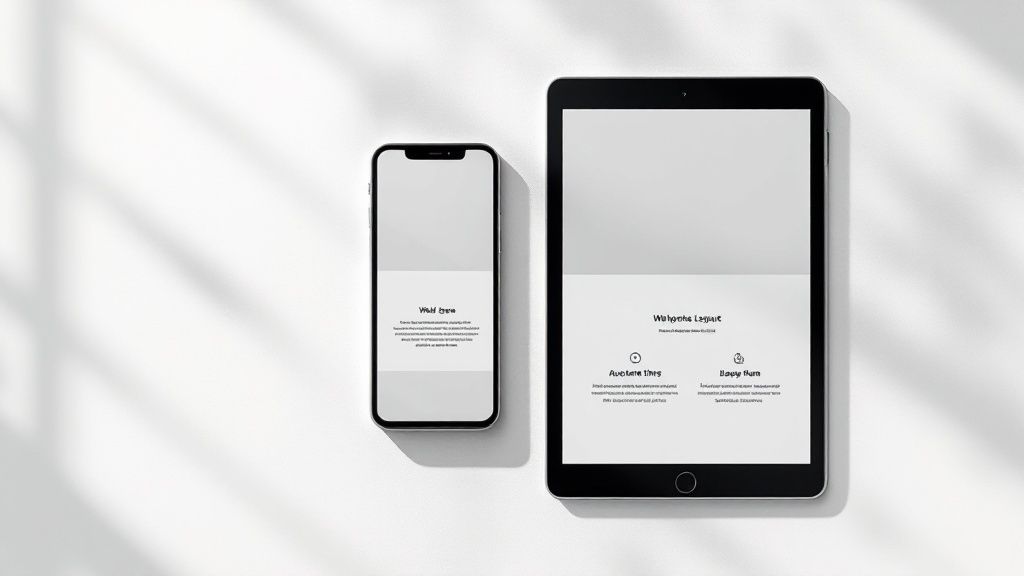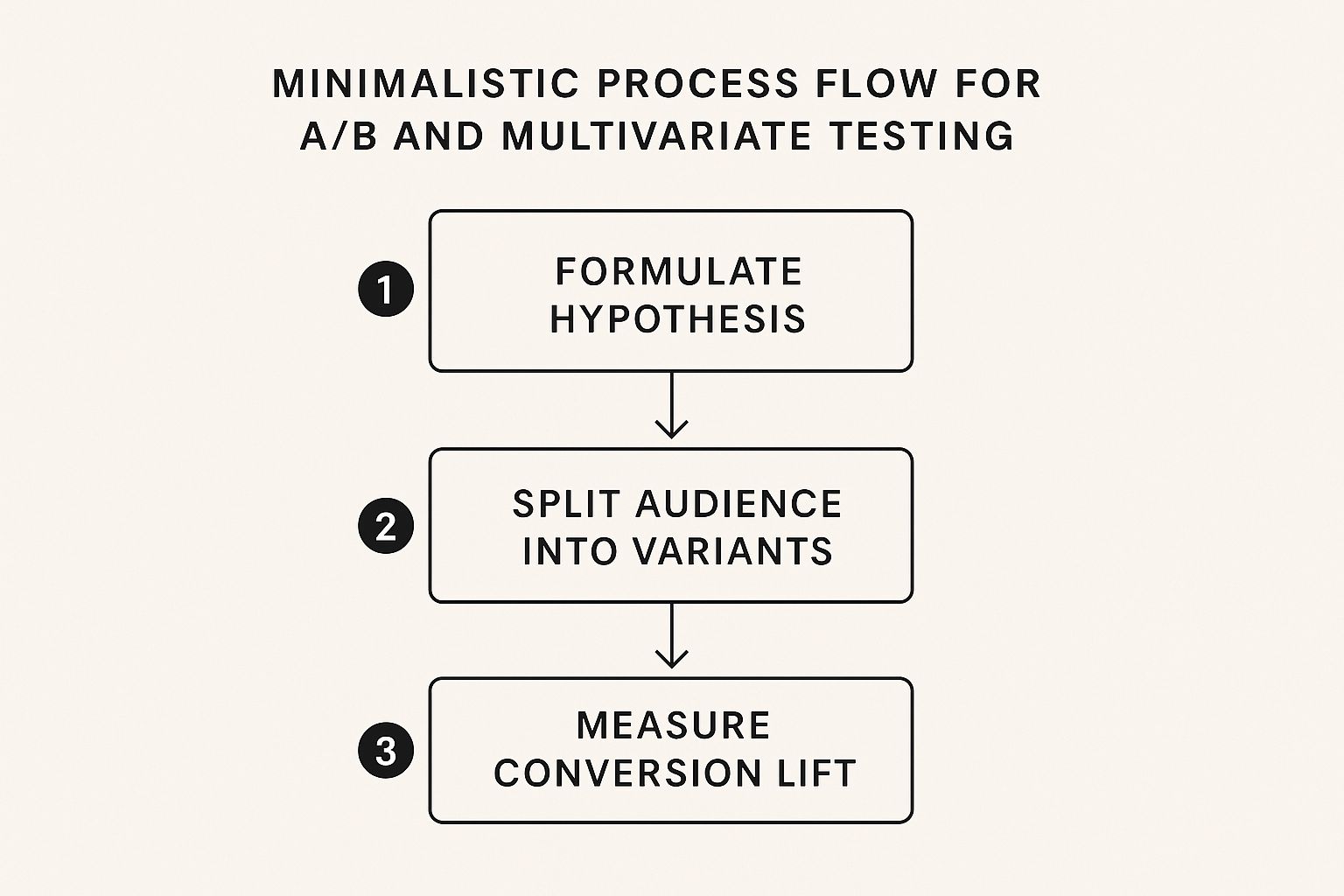Ultimate Conversion Optimization Checklist for 2025
May 7, 2025

Elevate Your Conversions
Want to transform more browsers into buyers? This conversion optimization checklist provides 10 actionable strategies to boost your Shopify store's performance. This list helps you identify key areas for improvement, whether you're just starting with conversion rate optimization (CRO) or looking to refine your current approach. From clear value propositions and mobile responsiveness to persuasive copywriting and A/B testing, this conversion optimization checklist offers practical advice to increase sales and revenue. Implement these strategies and watch your bottom line grow.
1. Clear Value Proposition
A clear value proposition is the cornerstone of any successful conversion optimization strategy. It's a concise and compelling statement that explains how your product or service solves a customer's problem, delivers specific benefits, and differentiates you from the competition. For e-commerce businesses, especially Shopify store owners, Shopify Plus brands, and email marketers, this is paramount. A strong value proposition answers the critical question: "Why should I buy from you and not someone else?" In the context of a conversion optimization checklist, ensuring your value proposition is immediately visible and compelling is crucial for reducing bounce rates and guiding visitors towards desired actions, ultimately increasing conversions.

A well-crafted value proposition needs specific features to be effective. It should have prominent placement "above the fold" so visitors see it immediately without scrolling. The messaging should be concise, benefit-focused, directly addressing visitor pain points. Finally, it must differentiate your brand from competitors in a meaningful way. For Shopify store owners, this could mean highlighting unique product features, exclusive bundles, superior customer service, or faster shipping times.
Pros of a Clear Value Proposition:
- Increases immediate visitor engagement: A compelling value proposition grabs attention and encourages visitors to explore your site further.
- Reduces cognitive load for visitors: By clearly articulating your offering's benefits, you simplify the decision-making process for potential customers.
- Improves quality of leads: A well-defined value proposition attracts qualified leads who are genuinely interested in your products or services.
- Sets appropriate expectations from the start: This minimizes misunderstandings and ensures that customers know what to expect from your brand.
Cons of Crafting a Value Proposition:
- Can be challenging to distill complex offerings into simple statements: Sometimes, it's difficult to summarize all the benefits into a concise message.
- Requires ongoing testing and refinement: What works today might not work tomorrow. Continuous A/B testing is necessary.
- May need different versions for different audience segments: Your value proposition should resonate with the specific needs and motivations of each target group.
Examples of Effective Value Propositions:
- Slack: "Where work happens" – simple yet effective at communicating the core value.
- Stripe: "Payments infrastructure for the internet" – clearly positions their offering within a specific market.
- Unbounce: "Build landing pages fast, get more conversions" – directly connects to user goals and desired outcomes.
Actionable Tips for Shopify Merchants:
- A/B test different value proposition statements: Experiment with various wording, phrasing, and benefit prioritization to identify what resonates best with your target audience.
- Include the primary benefit within the first 5-10 words: Grab attention immediately and communicate the core value quickly.
- Support claims with social proof when possible: Include testimonials, reviews, or trust badges to build credibility.
- Ensure messaging matches ad copy and referral source expectations: Maintain consistency across all touchpoints to avoid confusing potential customers.
This item deserves a top spot in any conversion optimization checklist because it's the foundation upon which all other optimization efforts are built. Without a clear and compelling value proposition, even the most sophisticated tactics may fall flat. Popularized by figures like Peep Laja (CXL), Simon Sinek ("Start With Why"), and the MECLABS Institute, the focus on a strong value proposition has become a core tenet of successful marketing and conversion rate optimization. For Shopify store owners, this is a crucial lever to pull to increase sales and improve overall business performance.
2. Mobile Responsiveness
In today's mobile-driven world, ensuring your online store delivers a seamless experience across all devices is paramount for conversion optimization. Mobile responsiveness refers to a website's ability to adapt its layout, design, and functionality to various screen sizes and orientations, providing an optimal viewing and interaction experience whether your customer is on a smartphone, tablet, or desktop. With mobile traffic now dominating the online landscape, accounting for over 50% of global web traffic, neglecting mobile optimization is akin to leaving money on the table. This is a crucial aspect of any conversion optimization checklist, especially for Shopify store owners, e-commerce managers, Shopify Plus brands, and email marketers.

Mobile responsiveness is achieved through responsive design, a development approach that uses flexible grids, images, and CSS media queries to dynamically adjust the website's layout based on the user's device. This ensures that elements like navigation menus, buttons, and text are appropriately sized and positioned for optimal viewing and interaction on any screen size. Features of a truly responsive design include touch-friendly interface elements, fast loading times even on mobile networks, simplified navigation designed for smaller screens, and properly sized text and buttons optimized for touch interfaces.
The benefits of mobile responsiveness are multifaceted. For starters, it allows you to reach the ever-growing segment of mobile users, expanding your potential customer base. Furthermore, it improves your search engine optimization (SEO), as Google now uses mobile-first indexing, meaning the mobile version of your site is the primary factor considered for ranking. A responsive design reduces bounce rates by eliminating the frustration mobile visitors experience on sites not optimized for their devices. Finally, it simplifies website maintenance by using a single codebase instead of managing separate mobile and desktop sites.
However, mobile responsiveness does present some challenges. Achieving a seamless experience across all devices can sometimes require design compromises, and testing becomes more complex as you need to ensure functionality across a range of devices and operating systems. In some instances, optimizing for mobile might require sacrificing some desktop experience enhancements. Additionally, performance challenges can arise with media-heavy pages on mobile networks.
Successful examples of mobile responsiveness abound. Amazon's mobile experience utilizes larger buttons and a streamlined checkout process, making purchasing on mobile devices incredibly easy. Airbnb's responsive design maintains key conversion elements like search filters and booking buttons across all devices, providing a consistent user journey. Shopify stores using responsive themes often report seeing 50%+ higher conversion rates on mobile, demonstrating the direct impact of this optimization on sales.
To implement effective mobile responsiveness for your Shopify store, consider these actionable tips:
- Test on actual devices: While browser emulators are useful starting points, testing on real devices is crucial to identify and resolve real-world usability issues.
- Utilize Google's Mobile-Friendly Test tool: This free tool helps pinpoint areas where your site falls short in terms of mobile optimization.
- Adopt a "mobile-first" design approach: When designing new pages, prioritize the mobile experience first, then adapt for larger screens. This ensures a streamlined and efficient mobile experience.
- Simplify forms for mobile users: Reduce the number of fields and use larger input areas to make form completion on mobile devices less cumbersome.
- Implement click-to-call functionality: Make it easy for mobile users to contact you directly by incorporating click-to-call buttons for phone numbers.
The concept of responsive web design was popularized by Ethan Marcotte, who coined the term. Google's mobile-first indexing initiative further cemented its importance, and Luke Wroblewski's "Mobile First" design philosophy provides a valuable framework for prioritizing the mobile experience. By embracing mobile responsiveness, you're not just following a trend, but investing in a crucial element of your conversion optimization strategy, ensuring your Shopify store is primed for success in the mobile-dominant era.
3. Optimized Call-to-Action (CTA)
A critical element in any conversion optimization checklist is the Call-to-Action (CTA). This is the element that explicitly tells users what action to take next, guiding them towards the desired conversion goal, whether that's signing up for a newsletter, making a purchase, or booking a consultation. A well-optimized CTA is the bridge between user interest and conversion. Its effectiveness directly impacts your bottom line, making it a crucial component of any successful e-commerce strategy, especially for Shopify store owners, e-commerce managers, Shopify Plus brands, and email marketers.
How Optimized CTAs Work:
Optimized CTAs leverage strategic design, placement, and messaging to maximize click-through rates. They aren't just buttons; they're carefully crafted prompts designed to persuade users to take the next step. This involves using persuasive language, visually appealing design, and strategic placement within the user journey. By understanding your target audience's motivations and pain points, you can craft CTAs that resonate with them and encourage action.
Features of an Optimized CTA:
- High visual contrast: The CTA should stand out from the surrounding elements on the page.
- Action-oriented language: Use verbs that encourage immediate action (e.g., "Get Started," "Claim Your Discount," "Shop Now").
- Clear and specific: The CTA should clearly communicate the benefit of clicking and the next step in the process.
- Strategic placement: Consider the user journey and place CTAs where they make the most sense and have the highest impact.
- Appropriate size and white space: The CTA should be large enough to be easily seen but not so large that it overwhelms the page. Sufficient white space around it further enhances visibility.
Pros:
- Direct impact on conversion rates: Even small changes to your CTA can significantly improve your conversion rates.
- Easy A/B testing: CTAs are easy to test and optimize through A/B testing, allowing for incremental improvements.
- Reduces visitor confusion: Clear CTAs guide users through the conversion funnel, minimizing drop-off rates.
- Clear success metrics: Click-through rates and conversion rates provide clear metrics to measure the effectiveness of your CTAs.
Cons:
- Over-optimization can backfire: Overly aggressive or misleading CTAs can damage your brand's credibility.
- Best practices vary: What works for one audience might not work for another. Testing and research are essential.
- Bottlenecks: A strong CTA is useless if other elements on the page (e.g., slow loading times, poor product descriptions) hinder the user experience.
Examples of Successful CTAs:
- Netflix's "Try 30 Days Free": Offers clear value with a low commitment entry point.
- Calendly's "Create Your Free Account": Makes getting started simple and frictionless.
- HubSpot's Smart CTAs: Personalized CTAs that adapt based on visitor characteristics, demonstrating relevance and increasing engagement.
Actionable Tips for Optimizing Your CTAs:
- Use first-person language: "Start My Free Trial" is more compelling than "Start Your Free Trial."
- Incorporate urgency (when appropriate): Phrases like "Limited Time Offer" or "While Supplies Last" can encourage immediate action.
- Test button colors: While contrast is key, experiment with different colors to see what resonates best with your audience.
- Prioritize primary CTAs: Ensure your main CTA stands out from secondary calls to action.
- Position strategically: Place CTAs after the key benefits and value proposition are clearly communicated, not just at the bottom of the page.
Why Optimized CTAs Deserve a Place in Your Conversion Optimization Checklist:
CTAs are the direct drivers of conversions. They're the final nudge that encourages a visitor to become a customer. Optimizing them is a high-impact, relatively low-effort way to improve your conversion rates and grow your business. By following the tips and examples provided, you can ensure your CTAs are working effectively to drive results for your Shopify store.
Popularized By:
The importance of optimized CTAs has been championed by marketing experts like Joanna Wiebe of Copyhackers, conversion optimization pioneer Oli Gardner of Unbounce, and is rooted in Robert Cialdini's principles of persuasion.
4. Form Optimization
Form optimization is a crucial element of any conversion optimization checklist, especially for Shopify store owners, e-commerce managers, Shopify Plus brands, and email marketers. It focuses on streamlining your data collection processes – think contact forms, newsletter sign-ups, checkout pages, and account creation – to minimize friction and form abandonment while maximizing completion rates. Since forms are often the final barrier between a visitor and a conversion (whether it's a lead, a sale, or a subscription), optimizing them for usability, clarity, and efficiency can significantly impact your overall conversion rates and bottom line. A well-optimized form contributes directly to a better user experience, leading to a smoother path to purchase and increased customer satisfaction. This is why form optimization deserves its place in any robust conversion optimization checklist.
How Form Optimization Works:
The core principle of form optimization is reducing the effort required for users to complete a form. This involves careful consideration of several factors:
- Minimal Field Count: Only ask for information that is absolutely necessary. Every extra field adds friction and increases the likelihood of abandonment.
- Logical Field Grouping and Sequencing: Group related fields together and arrange them in a logical order that follows the user's thought process.
- Inline Validation and Error Handling: Provide real-time feedback as users fill out the form, highlighting errors immediately and offering clear instructions on how to correct them. This prevents frustration at the submission stage.
- Multi-step Processes for Complex Forms: Break down long forms into smaller, more manageable steps. This can make the process feel less daunting and improve completion rates.
- Mobile-Friendly Input Methods: Ensure your forms are responsive and easy to use on mobile devices, optimizing input fields for touchscreens and smaller screens.
Features and Benefits of Optimized Forms:
- Directly Impacts Final Conversion Rate: Optimized forms make it easier for users to convert, leading to a direct increase in sales, leads, and sign-ups.
- Improves Data Quality and Reduces Errors: Clearer forms and real-time validation help ensure the data you collect is accurate and usable.
- Can Significantly Reduce Abandonment at the Critical Moment: By minimizing friction, you reduce the chances of users abandoning the form just before completing it.
- Often Produces Immediate Conversion Improvements: Form optimization can deliver quick wins and measurable results.
Pros and Cons:
- Pros: Directly impacts final conversion rate, improves data quality and reduces errors, can significantly reduce abandonment at the critical moment, often produces immediate conversion improvements.
- Cons: Reducing fields may compromise lead quality, implementation can require developer resources, complex validation rules may introduce technical issues, must balance business data needs with user experience.
Examples of Successful Implementation:
- Typeform: Their conversational form approach, breaking down forms into single-question steps, yields impressive completion rates of up to 59%.
- Expedia: They gained $12 million in profit simply by removing one redundant form field from their booking process, demonstrating the significant impact of minimizing form fields.
- Intuit's TurboTax: Their step-by-step form process makes the complex task of filing taxes feel more manageable, guiding users through each section and improving completion rates.
Actionable Tips for Shopify Store Owners and E-commerce Managers:
- Use Autofill and Smart Defaults: Pre-fill fields with information you already have (e.g., shipping address) to save users time and effort.
- Implement Real-Time Validation Before Submission: Provide immediate feedback on errors to avoid frustration.
- Show Progress Indicators for Multi-Step Forms: Let users know how far they are in the process to encourage completion.
- Consider Conditional Logic to Show Only Relevant Fields: Dynamically show or hide fields based on user input to personalize the experience and reduce clutter.
- Test Single-Column vs. Multi-Column Layouts: Single-column layouts often perform better on mobile and can improve clarity.
Popularized By:
- Luke Wroblewski's "Web Form Design" book
- Baymard Institute's form usability research
- Formstack's form conversion rate studies
By implementing these form optimization strategies, you can significantly improve your conversion rates and enhance the overall user experience on your Shopify store, leading to greater customer satisfaction and increased revenue. This makes form optimization an essential part of any comprehensive conversion optimization checklist.
5. Page Speed Optimization
Page speed optimization is a critical element of any conversion optimization checklist, directly impacting user experience, SEO, and ultimately, your bottom line. It involves fine-tuning your website to load quickly and respond efficiently to user interactions. For Shopify store owners, e-commerce managers, and Shopify Plus brands, this is especially crucial as every second of delay can lead to a significant drop in conversions – approximately 7% according to industry research. This means faster pages translate directly into more sales and a healthier ROI for your marketing efforts.
Why Page Speed Matters in Conversion Optimization:
In today's fast-paced digital landscape, users expect instant gratification. A slow-loading website leads to frustration, abandoned carts, and lost revenue. For mobile users, particularly those on less reliable connections, page speed is even more critical. By optimizing your site's performance, you're not only improving the user experience but also signaling to search engines that your site offers a high-quality experience, which can boost your SEO rankings.
Key Features of Page Speed Optimization:
Several technical aspects contribute to a faster website:
- Image Optimization and Compression: Large image files are a common culprit of slow loading times. Optimizing images involves compressing them without significant quality loss and using appropriate formats (like WebP).
- Minification of CSS, JavaScript, and HTML: This process removes unnecessary characters and whitespace from code files, reducing their size and improving download speed.
- Efficient Caching Strategies: Caching stores frequently accessed data, like images and scripts, so they can be retrieved quickly on subsequent visits. Leverage browser caching and consider implementing a Content Delivery Network (CDN).
- Content Delivery Network (CDN) Implementation: CDNs distribute your website's content across multiple servers globally. This allows users to access the content from a server closer to their location, reducing latency and improving loading times.
- Reduced Server Response Time: Your server's ability to quickly respond to requests is vital. Optimizing server configurations and database queries can significantly impact page speed.
- Prioritized Loading of Above-the-Fold Content: Ensure the content visible to users without scrolling loads first. This provides a perceived speed boost and improves the overall user experience.
Pros and Cons of Page Speed Optimization:
Pros:
- Improved User Experience Across All Devices: A faster website leads to a smoother, more enjoyable browsing experience for everyone.
- Positive Impact on SEO Rankings: Search engines favor websites that offer a good user experience, including fast loading times.
- Reduced Bounce Rates Significantly: Fast-loading sites keep users engaged and reduce the likelihood of them leaving prematurely.
- Increases Pages Per Session and Time on Site: A positive user experience encourages visitors to explore more pages and spend more time on your site.
- Particularly Impactful for Mobile Users: Mobile users are often on slower connections, making page speed even more crucial for this segment.
Cons:
- Can Require Significant Technical Expertise: Implementing some optimization techniques can be complex and require developer knowledge.
- May Involve Tradeoffs with Visual Richness: In some cases, optimizing for speed might require simplifying design elements or reducing image quality, though this is often minimal with modern optimization techniques.
- Ongoing Maintenance as Content Changes: As you add new content and features, you'll need to maintain your page speed optimization efforts.
- Can Conflict with Third-Party Scripts and Trackers: Some third-party scripts can slow down your site. Carefully evaluate and optimize their implementation.
Examples of Successful Page Speed Optimization:
- Pinterest: Reduced perceived wait times by 40% and increased sign-ups by 15% by improving page speed.
- Walmart: Found that for every 1-second improvement in page load time, conversions increased by 2%.
- COOK: Reduced page load time by 850ms, which increased conversions by 7%.
Actionable Tips for Shopify Store Owners:
- Use Google PageSpeed Insights: This free tool analyzes your website and provides specific recommendations for improvement.
- Implement Lazy Loading for Images and Videos Below the Fold: This technique only loads images and videos when they are visible in the viewport, significantly improving initial load time.
- Reduce the Number of HTTP Requests Where Possible: Each request adds to the loading time. Combining files and using CSS sprites can reduce the number of requests.
- Consider Performance Budgets for New Features: When developing new features, set performance goals to prevent regressions in page speed.
- Test Speed Across Multiple Devices and Connection Types: Ensure your website loads quickly on different devices and network conditions.
Influential Figures and Tools:
Google's PageSpeed Insights tool and Core Web Vitals initiative have popularized and standardized page speed optimization. Experts like Steve Souders and Ilya Grigorik, along with Google web performance engineers, have significantly contributed to the field.
By prioritizing page speed optimization, you’re investing in a better user experience, improved SEO, and ultimately, a more profitable online store. It's a fundamental aspect of conversion optimization that deserves a prominent place on every checklist.
6. Trust Signals and Social Proof
Trust signals and social proof are crucial elements in any effective conversion optimization checklist. They work by leveraging the psychological principle of social influence, where people are more likely to take an action if they see others have done so successfully. This is particularly important in e-commerce, where overcoming customer skepticism and building confidence is key to driving sales. These elements demonstrate credibility, reliability, and positive experiences from others, reducing perceived risk in the buying process and significantly improving conversion rates, especially for new or unknown brands.

Several features contribute to effective trust signals and social proof. These include customer testimonials and reviews, industry certifications and security badges (like Norton or McAfee Secure), media mentions and press logos, detailed product information and transparency about materials and sourcing, satisfaction guarantees and clear return policies, and social media proof such as follower counts and engagement levels. Case studies and success stories, particularly for Shopify Plus brands and B2B businesses, can also significantly boost credibility.
This approach is particularly effective for high-risk or high-cost purchases, where customers need more reassurance before committing. For example, a Shopify store selling high-end jewelry would benefit greatly from displaying testimonials and security badges. But even for lower-priced items, trust signals can make a difference by reducing purchase hesitation. This item deserves its place on the conversion optimization checklist because it directly addresses a fundamental aspect of online buyer behavior: the need for trust.
Pros:
- Builds immediate credibility with new visitors.
- Addresses common objections preemptively.
- Leverages the human tendency to follow others' actions.
- Particularly effective for high-risk or high-cost purchases.
Cons:
- Can create visual clutter if overused.
- Effectiveness varies by audience and industry.
- Requires ongoing collection and curation.
- Fake or manipulated reviews can backfire severely.
Examples:
- Basecamp's homepage features real customer quotes with photos and company names, lending credibility to their project management software.
- Shopify itself displays impressive statistics like the total number of merchants, countries served, and revenue processed, demonstrating their platform's widespread use and success.
- Booking.com uses real-time booking notifications ("Someone just booked a room in Paris!") to create urgency and social proof, encouraging visitors to book quickly.
Tips for Shopify Store Owners, E-commerce Managers, Shopify Plus Brands, and Email Marketers:
- Place testimonials strategically near points of friction or decision, such as on product pages or near the add-to-cart button.
- Use specific, detailed testimonials rather than generic praise ("Great product!"). Focus on the value proposition and how the product solved a specific problem for the customer.
- Include verification elements like photos, company names, and dates to enhance the authenticity of testimonials.
- Test different types of social proof for your specific audience. What works for one demographic might not resonate with another.
- Regularly update trust signals to maintain relevance and accuracy. Outdated information can erode trust.
- Learn more about Trust Signals and Social Proof for specific guidance on implementing trust badges in your Shopify store. This guide offers valuable insights for optimizing your store's credibility and boosting conversions.
By incorporating these tips and strategies into your conversion optimization checklist, you can effectively leverage trust signals and social proof to build customer confidence, reduce purchase hesitation, and ultimately drive more sales.
7. Persuasive Copywriting
Persuasive copywriting is a crucial element of any successful conversion optimization checklist. It goes beyond simply describing your products or services; it uses specific language patterns, structures, and techniques to actively convince visitors to take your desired actions, whether that's signing up for a newsletter, adding an item to their cart, or completing a purchase. Its place on this list is solidified by its direct impact on user behavior and, ultimately, your bottom line. For Shopify store owners, e-commerce managers, Shopify Plus brands, and email marketers, mastering persuasive copywriting is essential for maximizing ROI.
How it Works:
Effective conversion copy works by deeply understanding your target audience and addressing their needs and motivations. It focuses on the benefits customers receive rather than simply listing product features. For example, instead of saying "This camera has 12 megapixels," persuasive copy would say, "Capture stunningly detailed photos and videos of your most precious memories with crystal-clear clarity." This shift in focus paints a picture of the value proposition for the customer. It also employs a clear problem-solution framework, presenting the customer's pain point and positioning the product or service as the ideal solution.
Features of Persuasive Copy:
- Benefit-focused language: Emphasizes the positive outcomes for the customer.
- Clear problem-solution framework: Clearly articulates the customer's problem and offers a solution.
- Specific, concrete language: Uses vivid language to create mental images for the reader.
- Strategic use of power words and emotional triggers: Evokes specific emotions to motivate action.
- Scannable format: Employs headers, bullet points, and short paragraphs for easy reading.
- Customer-centric perspective: Uses "you" language to address the reader directly.
Pros:
- Directly addresses customer motivations and objections: Speaks directly to the customer's needs and concerns.
- Can be tested and iteratively improved: A/B testing can refine copy for optimal performance.
- Works in harmony with design elements: Guides users through the website and encourages desired actions.
- Helps qualify leads: Clearly communicates value and fit, attracting the right customers.
Cons:
- Requires specialized writing skills or resources: May require hiring a copywriter or investing in training.
- Effectiveness can vary by audience and context: What works for one audience may not work for another.
- Can come across as manipulative if not authentic: Must be used ethically and genuinely.
- Needs regular updating: Value propositions and customer needs can change over time.
Examples of Successful Implementation:
- Airbnb: "Belong Anywhere" – Taps into the emotional desire for connection and belonging.
- Mailchimp: Uses friendly, accessible copy that simplifies complex technical concepts related to email marketing, making it less intimidating for users.
- Dollar Shave Club: Disrupted the razor industry with direct, humorous copy that resonated with a target audience tired of overpriced razors.
Actionable Tips for Shopify Merchants:
- Write headlines that address specific customer problems or goals: Example: "Struggling to increase your average order value? Discover 5 proven strategies…"
- Use the AIDA framework (Attention, Interest, Desire, Action): Capture attention, build interest, create desire, and prompt action.
- Incorporate storytelling elements to increase engagement: Share relatable stories that resonate with your audience.
- Test different copy lengths for different audience segments: What works for email may not work for a product description.
- Use voice-of-customer data from surveys and support interactions to inform your language: Understand how your customers speak and what language resonates with them.
Popularized By:
- Joanna Wiebe (Copyhackers) and her conversion copywriting methodology
- Joe Sugarman and his "Triggers" persuasive writing techniques
- Ann Handley's content marketing and writing frameworks
By incorporating persuasive copywriting techniques into your conversion optimization strategy, you can significantly improve your website's performance and drive more sales. For e-commerce businesses operating on Shopify, this means optimizing product descriptions, collection pages, email campaigns, and even social media posts to resonate with your target audience and ultimately convert browsers into buyers. Remember, effective copywriting isn't just about selling; it's about connecting with your customers and providing them with compelling reasons to choose your brand.
8. A/B and Multivariate Testing
A/B and multivariate testing are essential components of any robust conversion optimization checklist. These data-driven methods empower you to systematically improve your Shopify store's performance by eliminating guesswork and focusing on what resonates with your customers. In essence, they provide a scientific approach to optimizing your website for conversions.
How it Works:
A/B testing involves comparing two versions of a webpage or element (A and B) to see which performs better against a specific conversion goal, like adding to cart or completing a purchase. Multivariate testing, on the other hand, allows you to test multiple variations of several elements simultaneously. For example, you might test different combinations of headlines, images, and call-to-action buttons all at once. Traffic is split between the different versions, and their performance is tracked and analyzed.
Why This Approach is Crucial for Conversion Optimization:
This methodical approach removes subjective opinions from the optimization process. Instead of relying on gut feelings, you're using concrete data to make informed decisions. This minimizes the risk of implementing changes that could negatively impact your conversion rates and fosters a culture of continuous improvement.
Features and Benefits:
- Controlled experiments with statistical significance: Ensure the results are reliable and not due to random chance.
- Traffic splitting: Exposes different user segments to different versions, allowing you to see what resonates with whom.
- Hypothesis-driven testing: Encourages a strategic approach based on user research and data analysis.
- Goal tracking: Focuses on metrics directly related to your conversion objectives.
- Statistical analysis: Provides clear insights into which version performed best and by how much.
Pros:
- Data-driven decisions: Replace guesswork with concrete evidence.
- Reduced risk: Minimize the chances of harming your conversion rates.
- Continuous improvement: Iteratively optimize your store for better performance.
- Unexpected insights: Discover hidden user preferences and behaviors.
Cons:
- Traffic requirements: Needs sufficient traffic volume for statistically significant results.
- Time investment: Proper implementation and analysis can take time.
- Potential for misinterpretation: Poorly designed tests can lead to incorrect conclusions.
- Technical expertise: May require specialized tools and knowledge.
- Temporary inconsistencies: Different versions can create temporary inconsistencies in user experience.
Examples of Success:
- Booking.com, a giant in the online travel industry, constantly runs hundreds of A/B tests to fine-tune their entire booking funnel, from the initial search to the final confirmation.
- The Barack Obama 2012 presidential campaign famously raised an additional $60 million by A/B testing email subject lines, highlighting the power of even small changes.
- Electronic Arts boosted conversion rates by a remarkable 40% by meticulously testing their registration process.
Actionable Tips for Shopify Store Owners, E-commerce Managers, Shopify Plus Brands, and Email Marketers:
- Prioritize high-impact pages: Start with high-traffic pages to see faster and more impactful results.
- Test substantial changes: Minor tweaks often produce weak signals; test bigger changes for clearer insights.
- Develop clear hypotheses: Base your tests on user research and data analysis. Don't just guess!
- Account for traffic patterns: Run tests long enough to account for daily or weekly fluctuations in traffic.
- Document everything: Keep detailed records of all tests and results to build organizational knowledge.
Learn more about A/B and Multivariate Testing specifically for Shopify. This resource provides valuable insights into leveraging A/B testing to enhance your store's performance.
By incorporating A/B and multivariate testing into your conversion optimization strategy, you can transform your Shopify store from a static platform into a dynamic, evolving ecosystem constantly adapting to user behavior and maximizing your revenue potential. This deserves a prominent place in any conversion optimization checklist due to its proven effectiveness in driving measurable improvements.
10. Mapping Your Customer Journey for Conversion Optimization
A crucial step in any conversion optimization checklist is understanding your customer's journey. Mapping this journey allows you to identify key touchpoints and optimize each stage for maximum conversion potential. By visualizing the steps a customer takes from initial awareness to final purchase, you can pinpoint areas of friction, identify opportunities for improvement, and ultimately create a more seamless and persuasive experience.

The infographic above visualizes a simplified customer journey, highlighting key stages and the interconnectedness of different marketing channels. It emphasizes the importance of nurturing leads through various touchpoints, from initial awareness generated through social media and search engine optimization (SEO), to consideration fostered by email marketing and content marketing, and finally, to conversion driven by targeted advertising and a compelling website experience.
This process, often visualized as a funnel, typically includes stages like Awareness, Consideration, Decision, Action, and Advocacy. Let's break down a simplified version shown in the infographic:
- Awareness: The customer becomes aware of your brand or product through various channels like social media, search engine results, or advertising.
- Consideration: The customer shows interest and begins researching your offerings, comparing them with competitors, reading reviews, and engaging with your content.
- Decision: The customer evaluates their options and makes a decision to purchase from you (or a competitor).
- Action: The customer completes the purchase.
- Advocacy: A satisfied customer may recommend your brand to others, leaving positive reviews, and becoming a repeat customer.
The sequence of these stages is crucial because it reflects the natural progression of a customer's buying process. Understanding this flow allows you to tailor your messaging and optimize each touchpoint to nudge the customer towards the next stage. For instance, awareness-stage content should focus on educating the audience about a problem your product solves, while decision-stage content should highlight the unique benefits and value proposition of your specific offering.
Examples of Successful Implementation:
- E-commerce stores using personalized email sequences triggered by specific customer actions (e.g., abandoned cart emails, product recommendations based on browsing history) are effectively leveraging customer journey mapping.
- Shopify Plus brands utilizing data analytics to segment their audience and tailor website content and offers based on customer behavior are optimizing the consideration and decision stages.
- Email marketers creating targeted campaigns that address specific pain points and offer tailored solutions are guiding customers through the decision-making process.
Actionable Tips for Shopify Store Owners:
- Identify your key customer touchpoints: Analyze your website analytics, social media engagement, and email marketing data to understand how customers interact with your brand.
- Create customer personas: Develop detailed profiles of your ideal customers to better understand their needs, motivations, and pain points.
- Map the journey: Visualize the steps a customer takes from initial awareness to final purchase, including the channels they use and the content they consume.
- Optimize each touchpoint: Tailor your messaging and offers to each stage of the journey to maximize conversion potential.
When and Why to Use This Approach:
Customer journey mapping is essential for any business that wants to improve its conversion rates. It's particularly valuable for e-commerce businesses, where the customer journey is often complex and involves multiple touchpoints across different channels. By understanding the customer journey, you can identify areas for improvement, create a more seamless and persuasive experience, and ultimately drive more sales.
Pros:
- Increased conversion rates
- Improved customer experience
- Better understanding of customer behavior
- More effective marketing campaigns
Cons:
- Requires time and resources to implement
- Data analysis can be complex
- Requires ongoing monitoring and refinement
This item deserves its place in the conversion optimization checklist because it provides a foundational understanding of the customer experience, enabling targeted optimizations at each stage of the buying process. By mapping the customer journey, businesses can move beyond generic marketing tactics and create personalized experiences that resonate with their target audience, ultimately driving conversions and fostering long-term customer loyalty. This is especially crucial for Shopify store owners, e-commerce managers, Shopify Plus brands, and email marketers who operate in a highly competitive online landscape.
10-Point Conversion Optimization Checklist Comparison
| Strategy / Best Practice | Implementation Complexity 🔄 | Resource Requirements 💡 | Expected Outcomes 📊 | Ideal Use Cases 💡 | Key Advantages ⭐ |
|---|---|---|---|---|---|
| Clear Value Proposition | Medium 🔄 – Requires refining messaging across segments | Moderate 💡 – Writing and testing resources needed | High 📊 – Increases engagement, reduces bounce rates | Early funnel engagement, messaging alignment | Improves visitor focus, lead quality, sets expectations |
| Mobile Responsiveness | High 🔄 – Complex multi-device design and testing | High 💡 – Design, development, and QA resources | Very High 📊 – Expands reach, boosts SEO, reduces bounce | Sites with significant mobile traffic, SEO-critical projects | Single codebase; better UX for mobile users |
| Optimized Call-to-Action (CTA) | Low to Medium 🔄 – Simple design changes with strategic placement | Low 💡 – Copywriting and design tweaks | High 📊 – Direct conversion rate improvements | Conversion-driven pages needing clear user direction | Quick to test; clear user guidance; measurable impact |
| Form Optimization | Medium to High 🔄 – Depends on form complexity | Moderate to High 💡 – Requires developers, designers | High 📊 – Increases completion rates, reduces abandonment | Data collection points where friction impacts final conversion | Improves data quality; reduces user drop-off |
| Page Speed Optimization | High 🔄 – Technical changes, ongoing maintenance | High 💡 – Developer expertise and tooling required | Very High 📊 – Reduces bounce, improves SEO & engagement | Content-heavy or media-rich sites; critical performance needs | Major impact on engagement; SEO boost; mobile-focused speed |
| Trust Signals & Social Proof | Low to Medium 🔄 – Content collection and placement | Low to Moderate 💡 – Content creation and curation | Medium to High 📊 – Builds credibility, lowers skepticism | New/unknown brands, high-risk or high-cost purchases | Enhances trust quickly; addresses objections |
| Persuasive Copywriting | Medium 🔄 – Requires specialized writing skills | Moderate 💡 – Skilled copywriters or training | High 📊 – Increases motivation and engagement | All conversion-focused content needing emotional connection | Addresses pain points; complements design; scalable |
| A/B and Multivariate Testing | High 🔄 – Setup, monitoring, and statistical analysis | High 💡 – Tools, traffic volume, and expertise | Very High 📊 – Data-driven incremental improvements | Mature sites with sufficient traffic seeking optimization insights | Removes guesswork; fosters continuous improvement |
Start Optimizing Today
This conversion optimization checklist provides a powerful roadmap for enhancing your online store's performance. From clarifying your value proposition and ensuring mobile responsiveness to optimizing CTAs and leveraging social proof, each item plays a crucial role in guiding visitors toward conversion. By focusing on persuasive copywriting, streamlined forms, fast loading times, and rigorous A/B testing, you can significantly improve your conversion rates and ultimately, your bottom line. Mastering these conversion optimization strategies is essential for any e-commerce business aiming to thrive in today's competitive landscape. These improvements translate directly into increased revenue, a larger customer base, and sustainable growth for your brand.
Implementing these tactics isn't a one-time fix, but rather an ongoing process of refinement and improvement. Start small, prioritize the areas with the biggest potential impact, and consistently analyze your results. The rewards of a well-optimized website are substantial and will contribute significantly to the long-term success of your business. For Shopify merchants seeking to further optimize their email marketing efforts and recover lost sales, explore Checkout Links. This powerful app streamlines email automation and reduces cart abandonment with personalized, shoppable links directly within your emails, further enhancing your conversion optimization strategy. Checkout Links
 Checkout Links
Checkout Links



